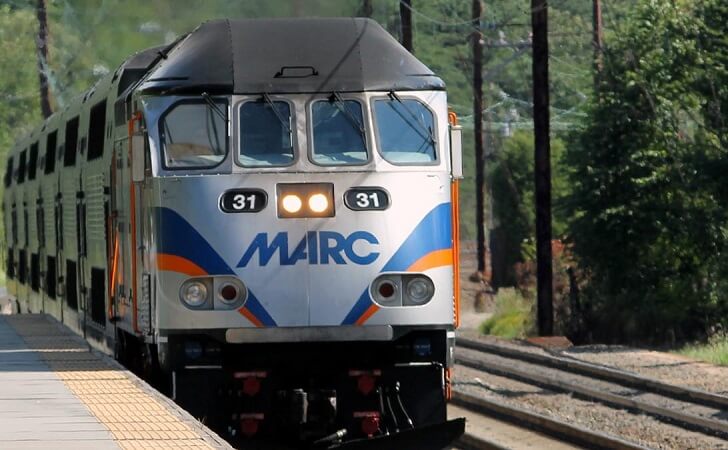On Transit, Pondering What Might Be and Lamenting What Might Have Been

In 2002, Maryland transportation planners put the finishing touches on a proposal to dramatically expand mass transit in the state. The plan envisioned six new or improved transit lines, with 122 new transit station stops built over 40 years.
Today, only the Purple Line, a light rail project linking New Carrollton to Bethesda, survives. The Red Line, an east-west transit project in Baltimore, came close to final federal approval, but Gov. Lawrence J. Hogan Jr. (R) pulled the plug on the project in 2015.
Earlier this year, the Hogan administration said it would provide no further funding for another proposed large-scale transit project, the Corridor Cities Transitway, in Montgomery County. That rapid bus line may not be dead, but it is, for now, on life support.
These projects were reviewed – and lamented – during a public discussion in Baltimore Tuesday night – fittingly, at the American Visionary Art Museum.
The discussion, sponsored by two regional business groups, the Greater Baltimore Committee and the Greater Washington Partnership, was designed to get community and stakeholder input about a new transit study the state is undertaking. This is known as the Regional Transit Plan for Central Maryland, and a draft is due to be completed in about a year.
But the past and present – there isn’t a single dollar set aside for new transit projects in the state’s recently released six-year transportation spending plan – hung heavy over the conversation.
“I can’t think of another time in recent history when the state’s capital program has had goose eggs for transit in the pipeline,” said John D. Porcari, who served as Maryland’s Transportation secretary under two governors and was also the deputy U.S. Transportation secretary during the Obama administration.
It takes years for proposed transit projects to become reality, Porcari said, and having none on the books for even planning or design means it will be a minimum of eight years before a transit project in Maryland can be in the queue for federal funding.
“A project has to survive several election cycles, at the federal, state and local levels,” he said.
Alicia Wilson, vice president for economic development at Johns Hopkins University and Johns Hopkins Health Care System, laid out long-term goals for improving mobility in the Baltimore region and for making the transportation system more equitable and reliable. Both she and Porcari suggested that however valuable it is to promote specific projects, the aim must be what helps people most and creates opportunity in underserved communities.
Mass transit in the Baltimore region pales in comparison to many U.S. cities. Transportation planners in the distant past went out of their way to marginalize communities of color.
“The reason we talk about underserved communities today is that conscious decisions were made to under serve those communities,” Porcari said.
Whether state and regional leaders are ever able to fashion a large-scale and well-planned transit system for Central Maryland is an open question. But officials’ inability to do so could have dire long-term economic impacts on the region.
Wilson, who joined Hopkins only recently, after being intricately involved in the Port Covington development in South Baltimore, recalled setting up a job training program at the project for young people, only to discover that they had no way of getting to their jobs. So she set up a shuttle service to aid the workers – something a number of large employers are doing around the country.
“There are not that many private companies that are going to figure out transportation to that level of detail for their employees,” Wilson said. “Nor should they have to.”
Wilson added that Amazon’s decision to bypass Baltimore as a finalist for its new headquarters – now under construction in Northern Virginia – was surely due in part to the region’s transit deficiencies.
The speakers at Tuesday’s forum were careful not to directly criticize the Hogan administration and its transportation priorities. Hogan has touted his commitment to the Purple Line and also points out that Maryland under his administration has committed to record funding for the Washington, D.C., area Metro system. Administration officials also argue that 42% of the state’s Transportation budget goes for transit, even though just 8.5% of Marylanders use transit regularly.
But Porcari, Wilson and people who asked questions Tuesday night said the state must simply be more strategic and more committed to transit – especially given the imperative of addressing climate change.
One small, easy and relatively inexpensive fix would be to build a MARC commuter rail station at the Johns Hopkins Bayview campus, they said. Another would be to refurbish the West Baltimore MARC stop.
Amtrak’s decision to invest millions of dollars at Baltimore’s Penn Station could be a catalyst for transit improvements and economic growth, Wilson and Porcari said, but the state and local investors must meet the challenge.
The Maryland Transit Administration’s Regional Transit Plan for Central Maryland is designed to lay out goals for expanding and improving mass transit in Anne Arundel, Baltimore, Harford and Howard counties and Baltimore City over the next 25 years. Planners envision a vast network of new transit service, using existing transit lines and new ones.
Eleven government officials and transportation professionals, designated by state and local agencies, are advising MTA on the outline.
Open houses are being held later this month to update the public on the plan’s progress. The sessions are:
— Oct. 21, from 4-6 p.m. at the Elkridge Library, 6540 Washington Blvd., Elkridge.
— Oct. 22, from 4-6 p.m. at the Towson Library, 320 York Rd., Towson.
— Oct. 24, from 4-6 p.m. at Mondawmin Hall, 2401 Liberty Heights Ave., Baltimore.
— Oct. 28, from 5-7 p.m., at the Edgewood Recreation and Community Center, 1980 Brookside Dr., Edgewood.
— Oct. 29, from 4-6 p.m., at the Severna Park Community Center, 623 Baltimore-Annapolis Blvd., Severna Park.




 Creative Commons Attribution
Creative Commons Attribution